How to Engage Employees in Tracking and Achieving Goals

Is everyone on your team working towards the same organizational goals right now? Does every person know how their daily contributions impact those goals? Does everyone have a clear picture of the current and forecasted financial state of the company?
In truly great cultures, employees know that the work they do matters, they can see the impact they are having, and they are recognized and rewarded for it. In a culture of performance, clear performance measurement systems work together to give everyone the information necessary to drive success. By engaging employees in tracking and achieving goals, you position everyone for a successful future.
Especially in times of uncertainty, putting systems around individual and organizational performance takes the guesswork out of performance management and predicting outcomes. In this latest installment of Stepping Up, you’ll meet four leaders who are seeing the hard work of building a culture of performance pay off — and they’re sharing the systems and tools they use to propel their organizations forward.
Here’s how to set goals, share financials, and manage performance like a Small Giant.
Meet the Leaders:
Vivian Lee, SVP of People Innovation
Arkadium is the ultimate creator of games designed for grown-up players. Its games are enjoyed by millions worldwide and can also be found on its own gaming site, Arkadium.com.
Sarah Grace Mohr, Chief Operating Officer
Experts in rapid financial improvement, MACKEY helps businesses and business owners gain control over their finances and achieve their wildest dreams.
Mitch Thobe, Chief Production Officer
Choice One Engineering is a civil engineering, surveying, and landscape architecture firm with the vision to change what people expect from businesses.
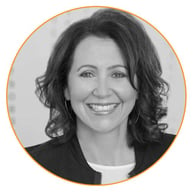
Deanna Walker, Partner - Business Development
Venturity Financial Partners offers outsourced accounting and fractional CFO services that help growing companies operate more efficiently by providing operationally-focused financial information.

Part 1: How to Set Better Goals (And Actually Achieve Them)
A culture of performance begins with organizational metrics. Organizational metrics get everyone on the same page about where the company is headed so that employees know exactly how they contribute to organizational goals. But what does goal setting look like on the individual level? And how should you track progress and offer support?
Let’s dig into two examples from Small Giant companies.

GOAL SETTING CREATES
TRUST & CLARITY
Vivian Lee, SVP of People Innovation
Arkadium
At a recent check-in with Arkadium CEO Jessica Rovello, Vivian Lee found that gratitude dominated the majority of their conversation. After dedicating significant energy to building a goal-setting framework for the 100 employees at their games company, the entire team had a sense of clarity and direction when they were suddenly separated by the pandemic.
“It’s really given our leadership team such a sense of trust knowing that everybody has their focus and is working on all the right things to propel the company forward,” says Lee. “Lack of trust or misalignment on goals can take up a lot of mental headspace for leaders and team members, and we’ve been able to eliminate that problem by having specific, aligned goals for everyone.”
For one week every quarter, goal-setting becomes a company-wide event at Arkadium. Kicking off with a set of goals set forth by the Leadership team, the Products team then spins its own set of goals based on that. From there, the company hosts an in-depth Q&A session for team members to get clarity, understand timelines, and get a sense of how they can impact each of the goals presented.
Next, each team member spends a few days writing their own individual goals that ladder up to the product goals — a process that everyone has been formally trained on. In order to ensure goals are clear, aligned, and everyone can work in full confidence, the People Innovation team holds ‘goal-setting office hours’ for everyone and offers access to goal-writing resources. Once goals are submitted, VPs on the Products team offer specific feedback for individuals.
By the end of the week, everyone on the team submits their goals for the quarter to the company’s performance management system (they use 7Geese).
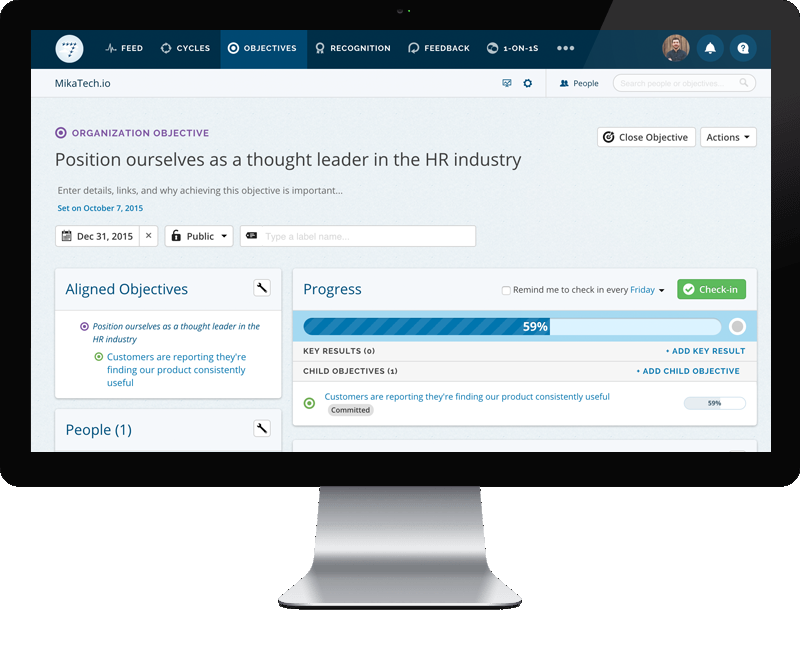
“Personal goals funnel up into product goals, which ultimately feed into our company goals,” says Lee. “The platform is very transparent and people are responsible for their own accountability — they continually update their progress and the program shows their completion rate for different KPIs. Our teams have a clear path forward and they have been so productive.”
Bonus! Peer-to-peer recognition may look different virtually, but that doesn’t make it any less important. Arkadium uses virtual badges to encourage team members to shout one another out for stepping up, exemplifying core values, and other accomplishments. Peer-to-peer recognition has actually increased 15 percent since they’ve gone virtual — the team had over 800 recognitions last quarter, celebrating 93 different team members.
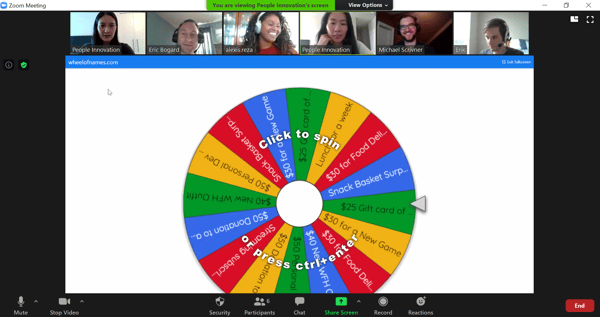
Looking for a new way to celebrate employee anniversaries (called ‘Arkversaries’ at Arkadium!), birthdays, and other milestones? Arkadium celebrates by offering a spin of their virtual prize wheel during Friday meetings, with fun and unique prizes like getting lunch sent to your home or picking out a new ‘work from home’ outfit.

INCENTIVIZING TEAMS
TO ACHIEVE SALES GOALS
Sarah Grace Mohr, Chief Operating Officer
MACKEY
As an organization committed to helping businesses and business owners gain control over their finances, the team at MACKEY has been pretty busy lately.
Internally, they’ve perfected an operating system that takes the best aspects of the many programs out there and molded it to fit how they work. Leveraging an OGSM model (stands for objective, goals, strategies and measures) for strategic planning and Level 10 meetings from the Entrepreneurial System (EOS) to move the ball forward, they’ve worked to crystalize a single strategic goal every month.
In August, the team set a goal of doubling the number of clients using its core service, Prosper for Business.
“We asked the team, ‘What would incentivize you to achieve this goal?’" says Chief Operating Officer Sarah Grace Mohr. “Mackey (our founder and my mother) makes great fried chicken, and they said they want a fried chicken feast for the whole team. If we surpass the goal by our September 15th deadline, we’re also going to throw in a bouncy house. We’re a fun team, so our goals and rewards should be fun, too.”
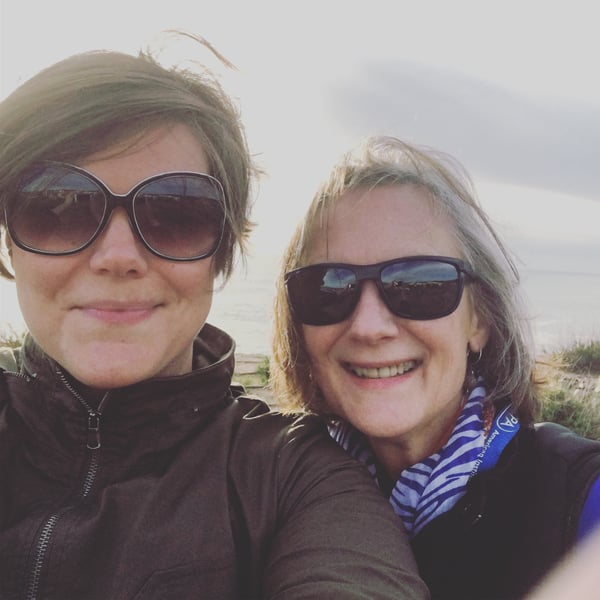
The team tracks progress towards the goal on a weekly basis, and they hold huddles for each department. They follow a cascading metrics model that allows them to document progress and create accountability toward achieving results without wearing everyone out with excessive meetings. As of today, they are 70 percent of the way there with 30 days left to hit the goal.
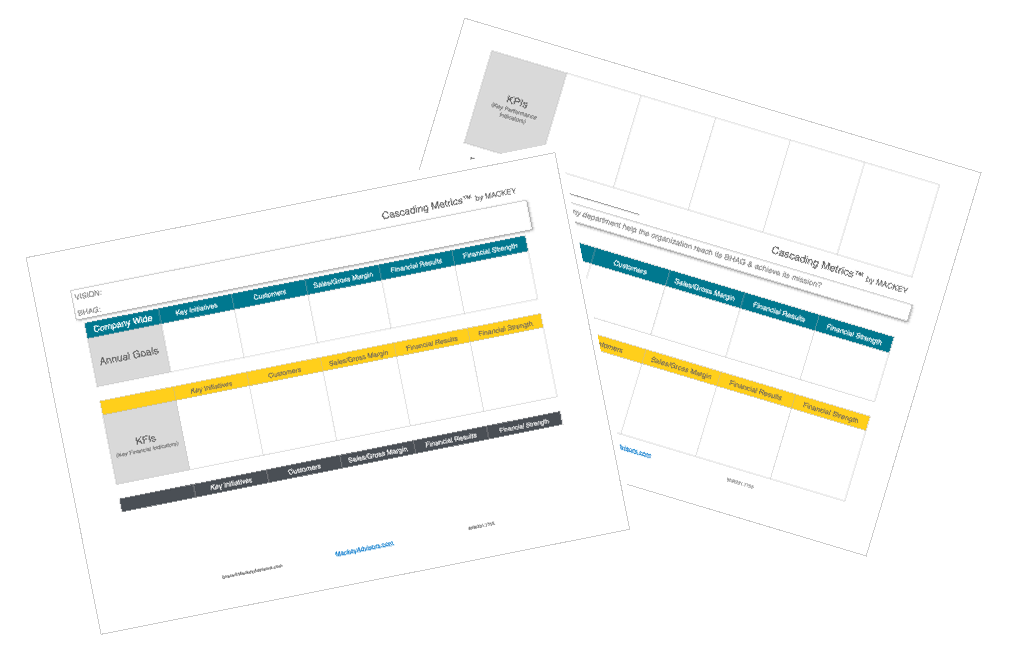
SELLING DURING A PANDEMIC
But in order to achieve their goal, they have to do some selling — how exactly do you sell during a pandemic? As Mohr explains it, they’re selling something that many people haven’t seen before (“It’s like if executive coaching and fractional CFOs had a baby”) and it’s a very intimate sales process. How do you achieve intimacy in a time when physical distancing is disrupting traditional sales processes?
It’s all about creating an experience and adding value, while also making the sale. Their team starts by asking small questions that opens the door to start building a relationship.
“We’re essentially offering a white-boarding, ideation session that gives them a taste of the MACKEY experience,” says Mohr. “We ask a series of questions that allow us to get intimate with them, but with no judgment. It’s all future-facing. Our value lies in our ability to make complex and scary topics manageable and, dare I say, fun. We help create a road map that’s no longer just in their head — and how we could help get them where they want to be much quicker.”
Back at the office, they have a conference room with 30 feet of floor-to-ceiling white board — but for now, they’ve innovated with video conferencing on Zoom, utilizing its annotation tools as well as customized templates to bring the ideation process to life for customers remotely. Mohr’s advice for those struggling to find magic in their sales process right now?
“Find a way to distill down your value into something that your prospect can experience briefly, but powerfully,” she says. “Create something that delivers a taste of your experience but doesn’t take too much energy or resources away from your sales team.”
Part 2: Forecasting as a Team with Transparent Finances
It may seem counterintuitive, but now might be the best time to be financially transparent with your team. People want to know what’s going on, and if you’ve got the right people on your team, they’ll want to do everything they can to positively impact the numbers.
Likewise, holding back the truth about your company’s financial position often backfires — instead of relieving your team from the burden of worrying about the numbers, you’re creating space for speculation and rumors to run rampant.
So how does financial transparency and forecasting as a team work during a crisis? Here’s how it’s playing out inside of two open-book organizations.

Team-driven forecasting
Deanna Walker, Partner - Business Development
Venturity Financial Partners
When thinking about what has gotten Venturity’s team through the COVID-19 crisis so far, Deanna Walker’s answer is clear: open-book management. Their team has been playing the Great Game of Business for three years now, and it’s given the entire team a clear playbook for navigating this time.
“Three days into the pandemic, I thought to myself, ‘Thank God for open-book management,’” says Walker. “Everybody knew what they needed to do right away, down to the client level – we already had the tools in place and it gave us a system to follow.”
The team forecasts for the current month on a weekly basis, and now they’re re-forecasting for the year at the beginning of each month. At the team level, they’re tracking how client decisions will impact the numbers and using tools they already have to forecast what it will mean for the company. They don’t always like what they see, but staying on top of it allows them to make informed decisions and get ahead of the curve.
But most importantly, this wasn’t a top-down process — the team drove the effort. Because the team is trained to think and act like owners, they knew how to move the ball forward on their own.
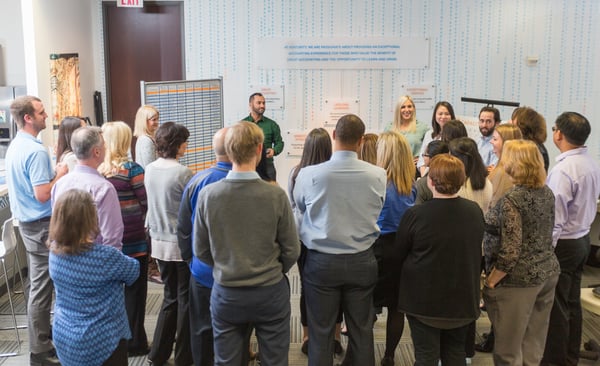
“Our people knew what to do,” says Walker. “It freed up space for the leadership team to focus on larger, strategic goals and live in the moment of what we were dealing with. Owning the financial piece also gave our people stability and insight into where they stand individually.”
Bonus! Should all companies open their books? The short answer is no — first, you must ensure you have the right team in place and a culture built on trust, shared values, and transparency. At Venturity, it all started when Walker and founder Chris McKee attended the Small Giants Community Summit for the first time in 2015.

“It inspired us to work on our culture,” says Walker. “We started putting systems around taking care of our people and building a strong foundation for our culture. Open-book management was the icing on the cake that gave us the methodology and discipline to enjoy the fruits of our labor.”

Eliminating the
financial unknown
Mitch Thobe, Chief Production Officer
Choice One Engineering
“People want to know what’s going on.”
Choice One has fully utilized open-book management for six years now, and it’s made transparent communication much easier on their team during this time.
“Though there are so many unknowns today, open-book management takes away that financial unknown of how the company is doing,” says Chief Production Officer Mitch Thobe. “Employees at other companies may not have the same chance at understanding that information. It is just one less story that people can create in their head.”
Everyone at Choice One has gone through financial training, which means everyone understands how a business works and what it needs to survive. Now, company leadership has full confidence that the team truly understands the numbers that impact their decisions — like what they’re forecasting for potential future revenue, cash flow, and aging, and how that affects both the business and them personally.
.jpg?width=600&name=Choice%20One%20(1).jpg)
“People want to know what’s going on.”
Choice One runs their huddles every Monday morning at 7:00am, with team members joining virtually from their own computers via Zoom.
“We go over our next three months’ forecasted revenue and then look at the current month’s forecasted income statement based on that month’s forecasted revenues and expenses,” says Thobe. “This allows everyone to know where the workload stands each week and allows people to make adjustments to their schedules accordingly. There are around 40 people involved each week in forecasting either a revenue or expense number.”
The way Thobe sees it, the more that people know, the more tools they have to improve the situation. Transparent communication also provides a sense of stability for their people — with so much uncertainty in all of our personal lives, financial transparency is a way to provide empowerment.
Part 3: Tracking Performance
with Scorecards
Performance scorecards are leveraged differently in every organization — some use a balanced scorecard for big-picture strategizing; others use interview scorecards to eliminate bias during the interview process.
There are two key areas where scorecards can make a major impact: individual and company-wide performance. Scorecards can help companies track trends and identify areas that need support at every level of the organization. It also helps create consistent alignment with goals and keep employees growing and improving throughout the year.
Here are two examples of how scorecards are used to empower employees and drive company results.
SCORECARDS FOR OUTCOMES
and competencies
Vivian Lee, SVP of People Innovation
Arkadium
Performance management doesn’t come easily to most leaders, especially when someone’s performing below expectations. Many struggle to succinctly convey the issue, and others just avoid bringing it up at all.
At Arkadium, every employee has an individual scorecard listing outcomes and competencies for their role. Twice a year, both the employee and manager rate the employee’s level of accomplishment for their role’s outcomes and competencies on a 5-point rating scale. For example, their role may require a Level 3 or higher in using Excel, and the employee only rates themselves as a Level 2 and needs support.
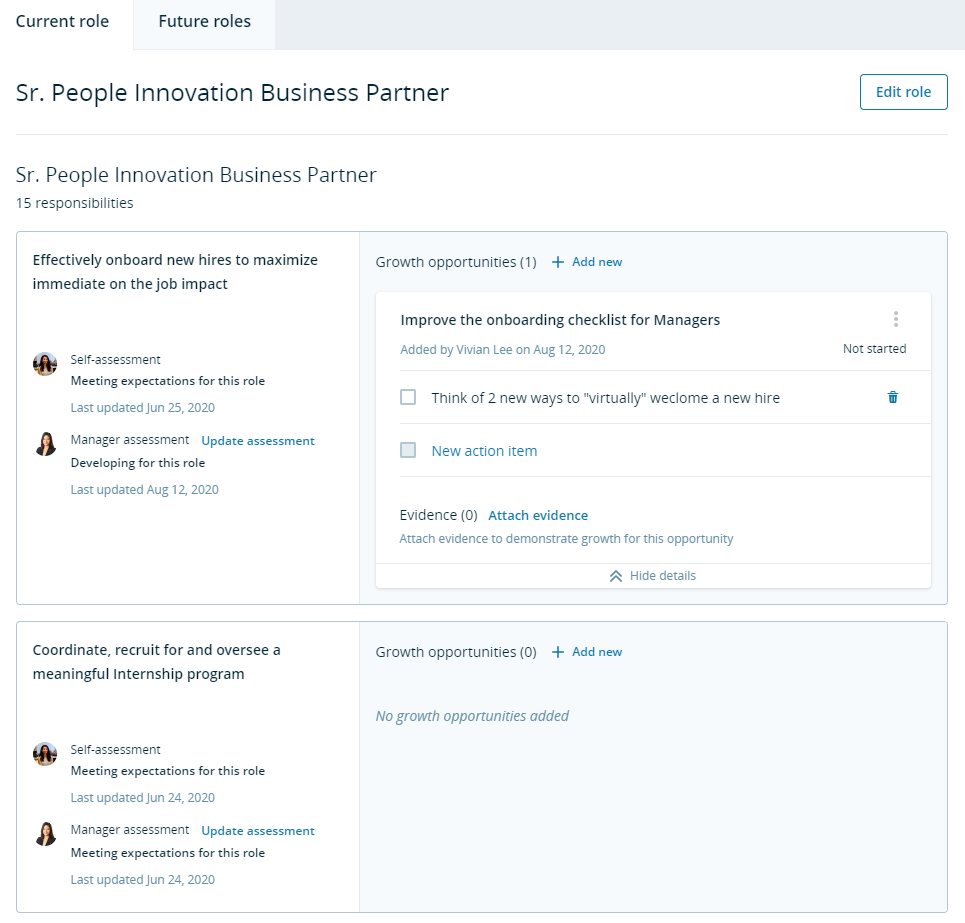
This process is a natural segue way for team members and managers to address any discrepancies in performance as well as perception.
“If there is misalignment, this process cuts straight to the point,” says Vivian Lee, SVP of People Innovation. “It’s a game changer for creating space for clarifying expectations and creating a growth plan where it’s needed. It’s also important not to overlook your A-Players — if someone is exceeding expectations and very driven, create an action plan that matches their ambition.”
What numbers should you
watch right now?
Mitch Thobe, Chief Production Officer
Choice One Engineering
What are the most important numbers for your team to watch right now? The answer may be different than it was pre-pandemic — at Choice One, their goal right now is to strengthen client relationships by checking in more frequently and having deeper conversations. To that end, the number of client touchpoints is now a lead measure they’re tracking every week.
“We feel that the more meaningful conversations we can have with current and potential clients will directly relate to the lag measure of number and dollar amount of proposals sent out,” says Chief Production Officer Mitch Thobe. “That is then directly tied to the lag measure of revenue.”
The other number they are watching closely is the number and dollar amount of proposals sent out, which links directly to the revenue they can expect in future months. Thobe is also keeping a close eye on cash — he advises leaders to remember that you can be a very profitable company and still be broke. If you don’t have cash on hand, you can’t pay your liabilities, which means you could be out of business soon.
“Along the same lines of cash, we also watch our aging closely,” says Thobe. “In a down economy, many people are holding onto their money tighter and longer. We continuously keep an eye on outstanding invoices and use that to help our project managers to stay on top of clients with outstanding invoices over 30 days.”
Ultimately, keeping close tabs on these numbers offers confirmation of what leaders like Thobe already know: they’re making the right moves with the right people, and their culture of transparency is paying off.
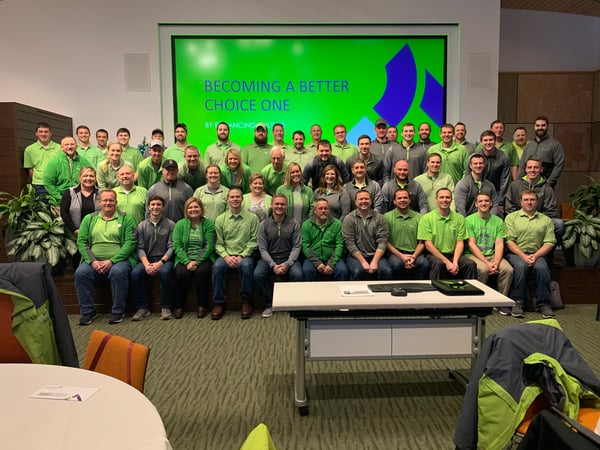
“We have a great group of employees and clients who have remained focused on the goals we set out to achieve pre-COVID,” says Thobe. “Our success speaks to our team’s determination and commitment to finding new ways of working within a situation that nobody planned for.”
A culture of performance creates trust and a strong foundation for your team, all while systematizing the things that matter most to your company. Without clear metrics at the organizational and individual levels, your employees are prone to feel misaligned, unmotivated, and unsure of how to achieve what’s expected of them.

Maybe your leaders are great at running their departments, but you wish they’d think about the bigger picture. Or maybe you’re interested in financial transparency, but you don’t think your employees will care about (or even understand) business finances.
Your emerging leaders have untapped potential, they just haven’t found the right training program yet. The Small Giants Leadership Academy guides your emerging leaders through a year of learning and connecting, introducing them to the systems, tools, and people to take their leadership — and your organization — to the next level.



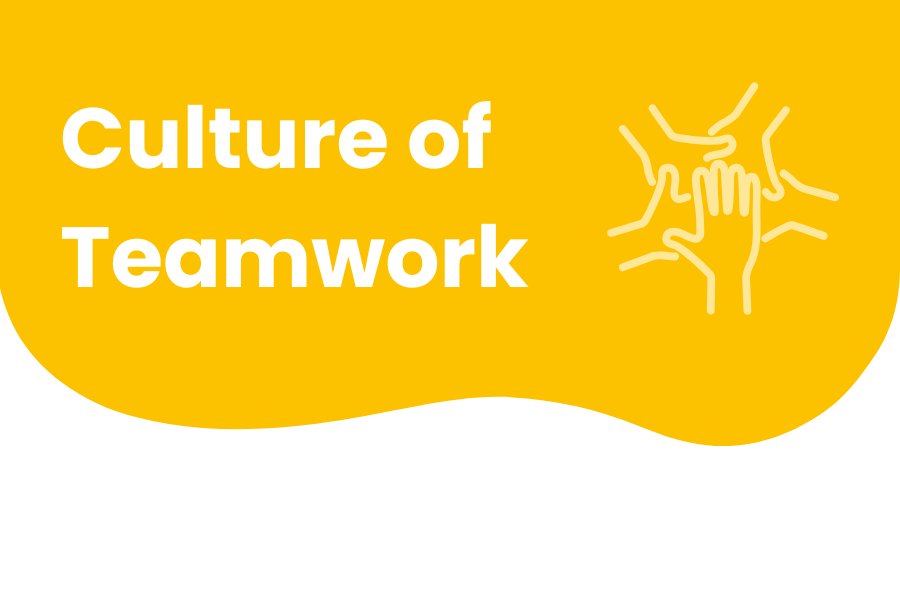
.png)
Submit Your Comment